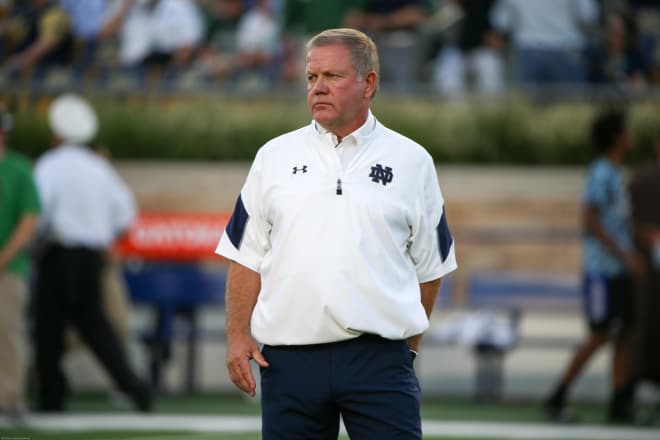Behind The '8' Ball At Notre Dame

Among the 15 Notre Dame full-time football head coaches since Jesse Harper in 1913, Brian Kelly is only the fifth to reach his eighth season.
The only four with longer tenures are the "Mount Rushmore" of the program: Knute Rockne’s 13 seasons (1918-30) prior to his premature death, and then the 11-year reigns of Frank Leahy (1941-43, 1946-53), Ara Parseghian (1964-74) and Lou Holtz (1986-96).
That quartet all had finished undefeated and/or won a national title in their third seasons (as did Dan Devine in 1977). In 2012, Kelly fiinished unbeaten in his third year as well (12-0) in the regular season, but lost in the title game. Such an achievement, however, after nearly two decades of mediocrity, probably brought Kelly much coaching equity — hence, year eight in 2017 despite a 4-8 record last year.
The four Mount Rushmore figures also experienced tremendous success in Year 7. Rockne (1924) and Leahy (1949) both finished 10-0 and won consensus national titles. Meanwhile, Parseghian (1970) and Holtz (1992) were 10-1 and 10-1-1 respectively — and both won the Cotton Bowl over unbeaten teams.
Conversely, Kelly's 4-8 mark in year 7 brought a firestorm of criticism and a multitude of skepticism.
What is interesting to note is that after those stellar seventh seasons, three of the four Notre Dame head coaches who made it to year 8 had disappointing results. Kelly likewise needs to reverse the trend for himself and the Fighting Irish in his eighth year.
Knute Rockne: Year 8 (1925)
Result: 7-2-1
In the six previous years Rockne was 55-2-1, most notably 10-0 the year prior that earned Notre Dame its first consensus national title.
This loss total match those of the previous six seasons combined, and included what would be his largest margin of defeat ever, a 27-0 loss to Army. The season ended with a 17-0 defeat at Nebraska.
After this season, Rockne signed a three-year deal at $25,000 per annum with Columbia University, far greater than the $10,000 he was making at Notre Dame. The deal was supposed to be done in confidence — especially because Rockne had a long-term deal with Notre Dame — but after Columbia alum James Knapp bragged about the deal and it made national headlines, the Irish head coach was embarrassed and returned as The Prodigal Son.
Frank Leahy: Year 8 (1950)
Result: 4-4-1
Just like his mentor Rockne, Leahy went through an unbelievable stretch before a significant dip in year 8.
In his first seven seasons with the Irish, Leahy was 60-3-5, with four consensus national titles, including 36-0-2 from 1946-49.
In 1950, though, the 4-4-1 outcome resulted in more defeats than his previous seven years combined.
How did it happen? One, the windfall of immense football talent that came to Notre Dame in 1946 following the end of World War II had concluded its four-year eligibility in 1949.
Two, football scholarships at Notre Dame were cut from 32 to 18 around 1947. The 1950 senior class, even with future College Football Hall of Fame members Bob Williams and Jerry Groom, saw the results.
Ara Parseghian: Year 8 (1971)
Result: 8-2
Despite the graduation of quarterback Joe Theismann, the Heisman runner-up in 1970, Notre Dame was the preseason No. 1 pick in the AP and by Sports Illustrated because of an impregnable defense and the return of virtually everyone else on offense.
Instead, for the first time in Parseghian’s eight seasons, the Irish finished outside the AP Top 10 (No. 13) while losing decisively to its two best opponents: 28-14 at home to USC and 28-8 at LSU in the finale.
Even at 8-1 and the week of the LSU game, the players were so disappointed with their campaign, they voted against an invitation to play in the Gator Bowl because it was “national title or bust.”
Lou Holtz: Year 8 (1993)
Result: 11-1
This was classified as a “rebuilding year” because the previous year’s backfield that consisted of first-round pick Rick Mirer at quarterback, first-round pick Jerome Bettis at fullback and second-round selection Reggie Brooks (fifth in the Heisman voting) at tailback. Plus, it also graduated first-round pick Irv Smith at tight end.
Meanwhile, the defense lost its top pass rusher (Devon McDonald), second-round linebacker Demetrius DuBose, and best cover man, first-round pick Tom Carter, who turned pro after his junior year.
All the departures left the Irish a “lowly” No. 7 in the AP preseason poll.
Notre Dame finished No. 2 — despite defeating No. 1 Florida State in November, 31-24. A Cotton Bowl win over Texas A&M was not enough to compensate for a 41-39 defeat at home to Boston College the week after the FSU game.
----
• Talk about it inside Rockne's Roundtable
• Subscribe to our podcast on iTunes
• Learn more about our print and digital publication, Blue & Gold Illustrated.
• Follow us on Twitter: @BGINews, @BGI_LouSomogyi, @BGI_CoachD,
@BGI_MattJones, @BGI_DMcKinney and @BGI_CoreyBodden.
• Like us on Facebook
